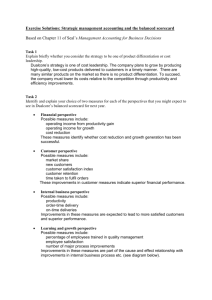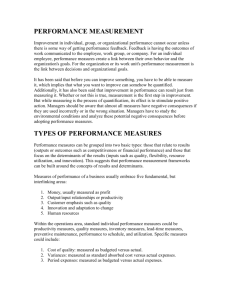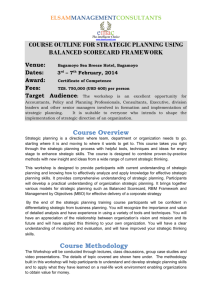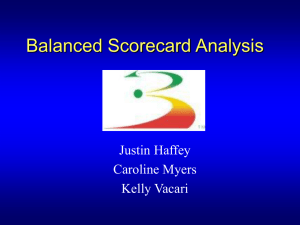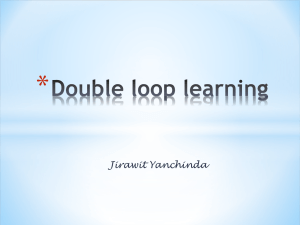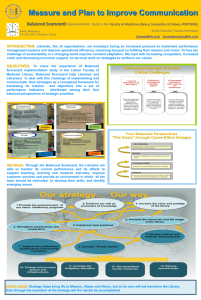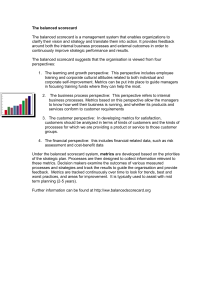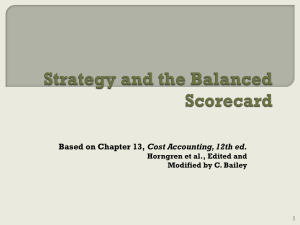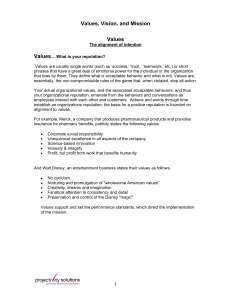Balanced Scorecard and Change Management
advertisement
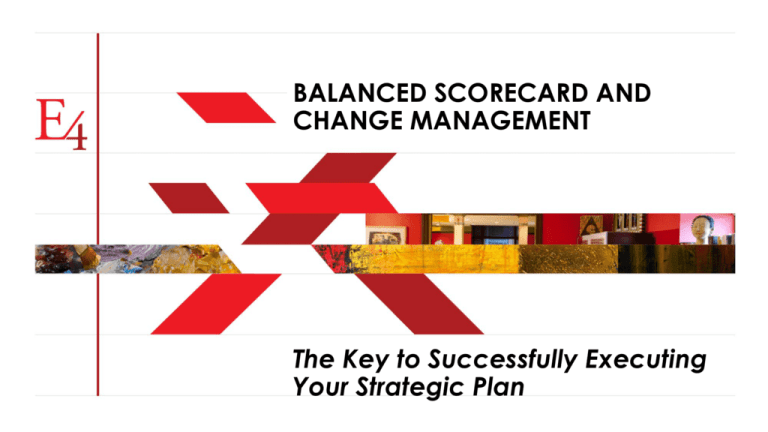
BALANCED SCORECARD AND CHANGE MANAGEMENT The Key to Successfully Executing Your Strategic Plan EXECUTING STRATEGIC PLANS KAPLAN & NORTON RESEARCH FINDINGS 9 out of 10 organizations fail to execute strategy 85% of senior executives spend less than one hour a month on strategy Only 5% of the employees understand the strategy 60% of organizations do not link budgets to strategy Translating strategy is more difficult than making strategy WHY DO MOST STRATEGIC PLANS FAIL? Failing to link strategy to operations – (Robert Kaplan & David Norton) Not adequately considering the human factor, i.e. organizational culture and people’s ability to adapt to change – (John Kotter) Inefficient planning of activities to accomplish the end – (Henry Gantt) THREE KEYS TO SUCCESSFUL EXECUTION OF STRATEGY 1 BALANCED SCORECARD (link strategy to operations) 2 CHANGE MANAGEMENT (consider culture and equip people to adopt change) 3 PROJECT MANAGEMENT (execute plans on time and on budget) BALANCED SCORECARD WHAT IS A BALANCED SCORECARD? At the highest conceptual level, the Balanced Scorecard is a framework that helps organizations translate strategy into operational objectives that drive both behavior and performance. BALANCED SCORECARD VS. DASHBOARD Balanced Scorecard is used for tracking strategic performance, i.e. how well the organization is executing its strategy. Dashboard is used for tracking operational performance, i.e. how well the organization is executing against operational goals. COMPONENTS OF A BALANCED SCORECARD Strategic Themes – These are the strategic focus areas of the organization. Objectives – The goal or outcome to be achieved. Measures – Leading/lagging measure of performance against the outcome. Targets – Level of performance or rate of improvement needed. Initiatives – Key action plan required to achieve the objective. FOUR PERSPECTIVES OF A BALANCED SCORECARD The Balanced Scorecard measures the organization’s performance across four “balanced” perspectives: 1. Financial 2. Customer 3. Internal 4. Learning & Growth (typ. human resources and IT) NON-PROFIT HIGHER EDUCATION EXAMPLE A balanced scorecard for a non-profit college or university may look like this: 1. Mission & Financial 2. Student/Parent and Grad School/Employer 3. Internal 4. Learning & Growth BUILDING A BALANCED SCORECARD Select the higher level outcome measure(s) for each objective. This is a lagging measure. Determine the operational driver(s) for the desired outcome measure. This is a leading measure. Create a Driver map to identify the leading measures for the scorecard. DRIVER MAP EXAMPLE Quick Problem Identification What outcome measures should we include in the BSC? Accurate Scripts Knowledgeable CSR’s What leading measures should we include in the BSC? CSR Training Hiring the Right People Reduce Service Cycle Time Resolve Problems on First Call Personalize the Interaction What is the outcome that we want to achieve? Improve Call Center Customer Satisfaction EXAMPLE CHANGE MANAGEMENT HOW PEOPLE RESPOND TO CHANGE Most people have a natural resistance to change Resistance should be expected and planned for when change is occurring 4 Phases of Resistance (Karl Schoemer) 1. Betrayal 2. Denial 3. Identity crisis 4. Search for solutions RESPONSE AND COMMUNICATIONS Stage Type of Communication Needed Betrayal Just the facts (What, When, Why) Denial Just the facts (What, When, Why) Identity Crisis “It’s going to be alright” Search for Solutions “Help us make it great!” Productivity 1 Current State Transition 4 2 3 Future State HELPING EMPLOYEES ADAPT TO AND ADOPT THE CHANGE Prosci’s ADKAR® Model PROSCI’s ADKAR Model Awareness • Of the need for change • Of the nature of the change Reinforcement Desire • To sustain the change • To build a culture and competence around change • To support the change • To participate and engage Ability • To implement the change • To demonstrate performance Prosci © 2010 Knowledge • On how to change • On how to implement new skills and behaviors THE TOOLS OF CHANGE MANAGEMENT Change Readiness Assessments Change characteristics Organizational attributes Sponsorship Model and Roadmap Master Change Management Plan Coaching Plan Training Plan Communication Plan Roles/Responsibility Current State/Future State Start/Stop/Continue KEYS TO SUCCESSFUL CHANGE MANAGEMENT Develop an internal change management competency Ownership Develop the competency among middle and senior managers Executive sponsorship of change initiatives Budget for change management Start your change management planning at the same time as you start your action planning Develop a communications strategy before you develop a communications plan Questions?

